The Nebulae Continued
Page Two









Zooming in on Messier 20 - the Trifid Nebula
Hubble image reveals details in heart of the Trifid Nebula
NASA NEWS RELEASE
Posted: June 5, 2004
Though the headline wasn't spectacular (after all, Hubble was, by this time, knocking out award winning images like the Treasury printing one dollar bills) but when I saw the images I was amazed. Stellar birth close up and personal. Today we have the Akari's infrared camera snapping images like that of IC 4954 shown at the beginning of page one, but nothing like the one Hubble took of the Trifid Nebula, all 2400 by 3000 pixels of it! But before we zoom-in, let's first look at the the original Hubble image, as well as others, of the Trifid Nebula:
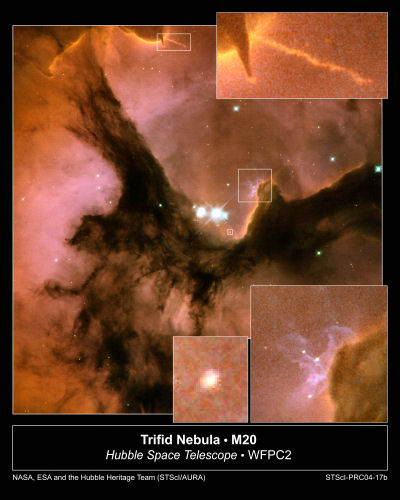
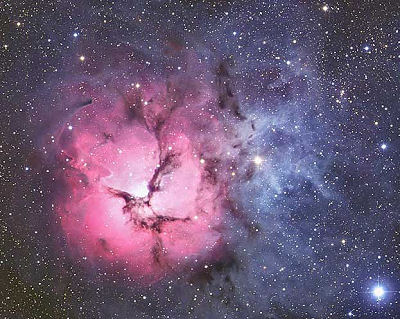
The Trifid Nebula, Messier 20 or NGC 6514. The Nebula lies within our Milky Way galaxy, about 9,000 light-years from Earth, in the direction of the constellation Sagittarius. Anglo-Australian Observatory Photograph by David Malin & seen at APOD
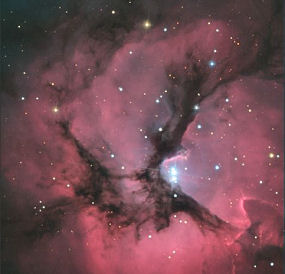
And here's another view, this time seen in the red emission light from Hydrogen APOD Credit & Copyright: Jim and Janet Castano, Adam Block, NOAO, AURA, NSF

Perhaps most famous of all is the the above image entitled "Trifid Pillars & Jets" APOD Credit: J. Hester (Arizona St. U) et al., WFPC2, HST, NASA.
Zooming in on the area of stellar birth. Credit: NASA, ESA, and The Hubble Heritage Team (AURA/STScI). The article and the following images can be found HERE. Meanwhile, let us peer into this stellar nursery. The first area we'll look at is marked with the light green arrow.
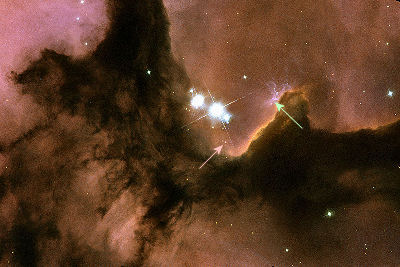
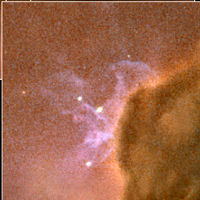
"The group of bright O-type stars at the center of the Trifid illuminates a dense pillar of gas and dust, seen to the right of the center of the image, producing a bright rim on the side facing the stars. At the upper left tip of this pillar, there is a complex filamentary structure. This wispy structure has a bluish color because it is made up of glowing oxygen gas that is evaporating into space." [ Source Space Flight Now ]
Hunting for a little O2 in Space
The Dark Coalsack Nebula from Aladin previewer in R[g]B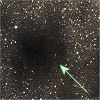
Unlike the more ubiquitous Hydrogen gas, Oxygen is one that is very scarce within the universe while at the same time a very important one, especially as it pertains to the formation studies of a galaxy, nebula or star. Oxygen has also been very hard to trace in the universe - remember, the gas component of the interstellar medium is made mostly of hydrogen (75%), some helium (25%) and then trace amounts of heavier atoms. In a study of the Coalsack Nebula:
"The authors had been using FUSE to study how cold gas clouds dissipate at their edges when their observations of the Coalsack came back with signs of oxygen VI , oxygen atoms with five of their eight surrounding electrons stripped away.
Astronomers know that considerable energy is required to knock that many electrons off an oxygen atom, and as a result have long interpreted the presence of oxygen VI as a sign that very hot gases are entering a cooling process. How this cooling process occurs - through turbulent mixing of the gas with colder gas clouds or through conduction of electrons - is a topic of debate among astronomers that further study of the Coalsack may help resolve."
They later concluded that,
´If our model of the Coalsack is right, then you can use it to test various theories of oxygen VI generation, and this may help us better understand what are the mechanisms behind previously detected oxygen VI production in many more distant parts of the galaxy,´ Andersson comments. ´This could tell us something about energy production in the galaxy, and that could in turn tell us more about star formation.´ " [ see Hot gas around cold dust cloud surprises astronomers Press release of Tuesday, May 27, 2003 from Johns Hopkins University
The Odin Space Observatory
In a more recent attempt to locate the elusive Oxygen molecule in space a team of scientist using the Odin Space observatory found:
"After careful processing and detailed analysis of more than 300,000 spectra, the oxygen line is convincingly visible, at a level of five times above the noise."
This only after,
"Earlier attempts to find the elusive oxygen molecule frustrated observatories on the ground and in space until space researchers realized something crucial," said Michel Fich, UW professor of physics and astronomy. "The abundance of oxygen was much lower than assumed before the search started. The Odin measurements have now told us just how low."
"The search, a principal goal of Odin, is important to understanding the chemistry in large interstellar clouds, the birthplaces of planets and stars." - from International team discovers molecular oxygen in space News Release of 2007-05-03 09:56:09 from the University of Waterloo.
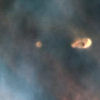 Proplyds or PPD's like the one to the left are the circulstellar discs rotating around an infant star as it forms.
Proplyds or PPD's like the one to the left are the circulstellar discs rotating around an infant star as it forms.

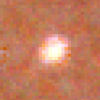
However, not far away there are signs of interstellar material collapsing under its own gravity, leading to ongoing star formation. One such example (light red arrow) is a very young star that is still surrounded by a ring of gas and dust left over from the star's formation. These circumstellar rings, called protoplanetary disks, or "proplyds" for short, are believed to be the locations where planetary systems are formed. Space Flight Now

Lastly, looking back to our image of the Trifid Nebula above, we see another very prominent stellar feature associated with stellar birth - the Jet ( gray arrow ). "In the box at upper right, a jet of material is seen being ejected from a very young, low-mass star. The jet, extending to the lower right of the box, protrudes from the head of a dense pillar and extends three-quarters of a light-year out into the surrounding thin gas. The jet's source is a very young stellar object that lies buried within the pillar. Previous Hubble images of the Trifid Nebula, taken in 1997, show very small, but noticeable changes in the knotty material being ejected from this jet. Accompanying the jet is a nearby stalk that points directly toward the central stars in the Trifid Nebula. This finger-like stalk is similar to the large pillars of gas in the well-known Eagle Nebula, also imaged by Hubble." see Ibid
We'll be discussing jets, their formation and types in a later (unwritten) section of this web site, under the title "Herbig-Haro Objects: Jets of the Universe"
Credits & Further Reading
25 x 25 arcmin DSS/POSS II image of IC 1590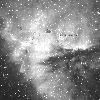
CLOUD FRAGMENTATION AND PROPLYD-LIKE FEATURES IN H II REGIONS IMAGED BY THE HUBBLE SPACE TELESCOPE from The Astronomical Journal, 131: 2580—2600, 2006 May
In our next page ( still under construction ) we'll be discussing Diffused ( Emission and Reflection ) Nebulae. Until then, thank you for stopping in and ciao!
for further study

 NASA Goddard Space Flight Center
NASA Goddard Space Flight Center
Nebulae & Starbirth
Diffused Nebula - Under Construction
Main Page
This Page
Nebulae & Starbirth
Next Page
Working On
Back to the Main Page
 Astronomers Discover Edge-on Protoplanetary Disk in Quadruple Star System from NOAO
Astronomers Discover Edge-on Protoplanetary Disk in Quadruple Star System from NOAO
Since this is an evolving website (a scientific way of say "always under construction") many of the pages on this site are continually being added to or updated. I do so as time permits and in a rotational fashion. As such, I'll be continuing this section after adding to those next in line. So please check back in two weeks or so.
Future upcoming chapters:
◊ Reflection Nebulae
◊ Planetary Nebulae
◊ Supernova Remnants
◊ Protoplanetary Nebulae